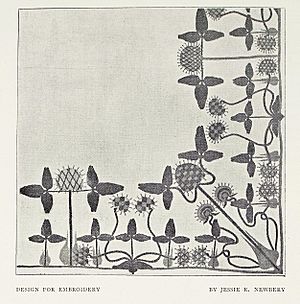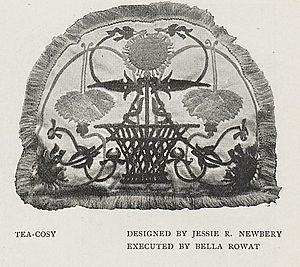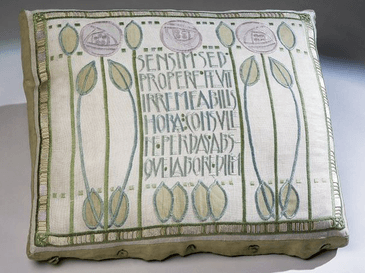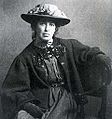Jessie Newbery facts for kids
Quick facts for kids
Jessie Newbery
|
|
|---|---|
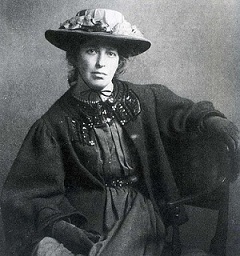 |
|
| Born |
Jessie Wylie Rowat
28 May 1864 |
| Died | 27 April 1948 (aged 83) |
| Nationality | Scottish |
| Education | Glasgow School of Art |
| Known for | Decorative Arts, Design |
| Movement | Art Nouveau, Glasgow Style, Symbolism |
| Spouse(s) | Francis Newbery |
Jessie Newbery (born May 28, 1864 – died April 27, 1948) was a Scottish artist. She was especially known for her amazing embroidery skills. Jessie was one of the talented artists called the Glasgow Girls.
Newbery also started the first Department of Embroidery at the Glasgow School of Art. Here, she helped make needlework a respected form of art. In 1889, she married Francis Newbery, who was the director of the art school.
Contents
Early Life and Learning
Jessie Newbery was born Jessie Wylie Rowat in Paisley, Scotland. Her mother was Margaret Downie Hill, and her father, William Rowat, was a shawl maker. He had many new ideas for his time.
When Jessie was 18, she visited Italy. This trip sparked her lifelong love for textiles and other decorative arts. Decorative arts are things like pottery, furniture, and textiles that are both useful and beautiful. In 1884, she began studying at the Glasgow School of Art.
Her Art and Career
Jessie Newbery became a very skilled and creative embroiderer. Even though embroidery wasn't a main subject at the Glasgow School of Art, she changed that. Other artists, known as "the Four" – Charles Rennie Mackintosh, Herbert McNair, Frances Macdonald, and Margaret Macdonald Mackintosh – also used embroidery in their designs.
In 1894, Jessie Newbery started the first embroidery class at the school. Her embroidery designs were very different from what was usually seen. She used styles that reminded people of older, 17th-century designs. Her work often featured flowers with sharp, angled stems. She is famous for creating the "angular Glasgow rose," which looked a bit like a cabbage. She also added new Glasgow Style lettering to her embroidery.
Teaching and New Ideas
Students took her embroidery classes as an extra subject. Some hoped to become professional embroidery artists. Around 1900, the Scottish Education Department suggested that embroidery should be taught in all schools. Because of this, many women teachers joined Newbery's classes to help with their teaching skills.
Jessie Newbery was known as an "enthusiastic teacher." She encouraged her students to be very creative with their designs. She made it easy for women to join her classes and changed the lessons to be more open. She wanted embroidery to be seen as an art form for everyone, no matter their social class or gender. She even started an Embroidery Department and Saturday classes at the Glasgow School of Art, which over 100 women attended.
Her Unique Style
Newbery was very careful about the colors and materials she used. She liked lighter colors like soft purples, greens, blues, and pinks. She also encouraged students to try "unusual techniques," such as needle weaving. She added things like beads, ribbons, and even card to her work.
Jessie believed that design was just as important as how useful something was. She said, "I believe that nothing is common or unclean: that the design and decoration of a pepper pot is as important in its degree, as the conception of a cathedral." This meant she thought every object, big or small, deserved to be beautiful. People admired her for making everyday things both beautiful and useful.
Newbery included ideas from the new Glasgow Style in her designs. She also helped shape this art movement. With her husband, she promoted new types of art at the Glasgow School of Art, like metalwork, glasswork, pottery, and woodcarving. The Glasgow Boys were a group of artists who challenged old art rules. Jessie and Francis Newbery then helped create the Glasgow Girls. This group explored many different art forms, putting crafts like embroidery on the same level as other fine arts.
She also taught how to design clothes along with embroidery. She thought clothes should be practical but also beautiful. This idea for women's clothing was seen as very modern and bold. Newbery often wore loose, comfortable styles herself, using silk velvets and light wools that she embroidered. She also taught classes in mosaics, enamels, and even book decoration.
Supporting Women's Rights
Jessie Newbery was an active member of the Glasgow Society of Lady Artists. She helped many women artists become members and offered them places to show their work. She strongly believed that women should have a bigger role in society.
She was also an active member of the Women's Social and Political Union, which fought for women's right to vote (suffrage). In 1910, she helped organize the "Arts and Curios" stall at a big event in Glasgow. She also helped make materials for the suffrage movement, like banners. One famous banner, made with Ann Macbeth, had the embroidered signatures of 80 women who had been force-fed in prison. This banner was carried in a large procession in London in 1911.
Later Life
After an illness, Jessie Newbery retired in 1908 as the Head of Embroidery at the Glasgow School of Art. Her former student, Ann Macbeth, who had been her assistant, took over her role.
Even after retiring, Newbery continued to create her own art. She showed her embroidery in exhibitions, including one at the famous Louvre museum in Paris. In 1911, she helped plan the Scottish Exhibition of National History, Art and Industry. She was on the committee for the Decorative and Fine Arts Section.
Jessie Newbery passed away in Corfe Castle, Dorset. She and her husband, Francis Newbery, had moved there after they retired.
Images for kids


